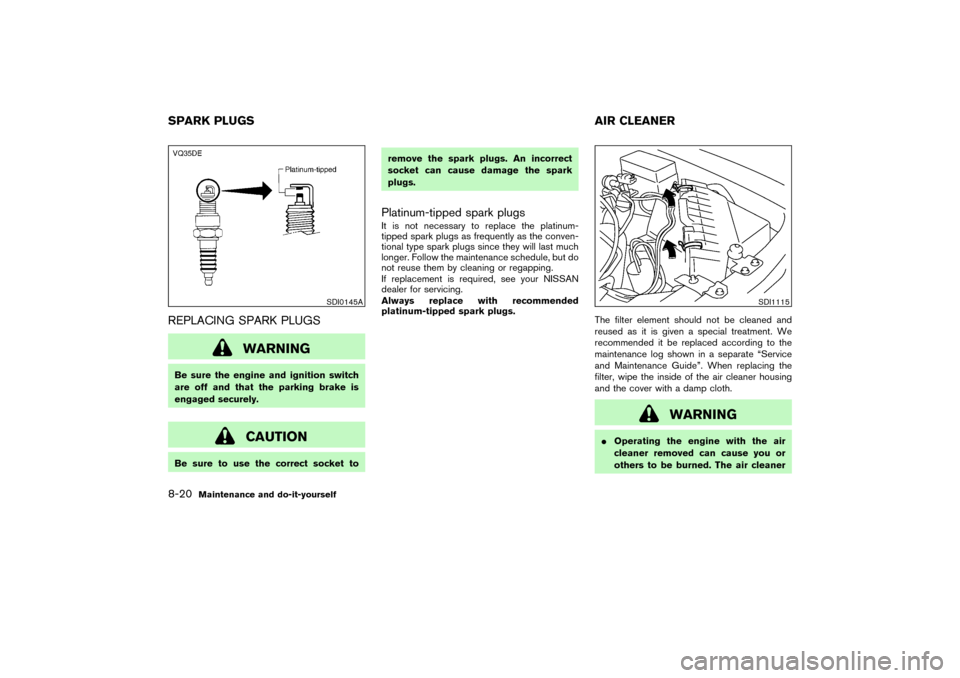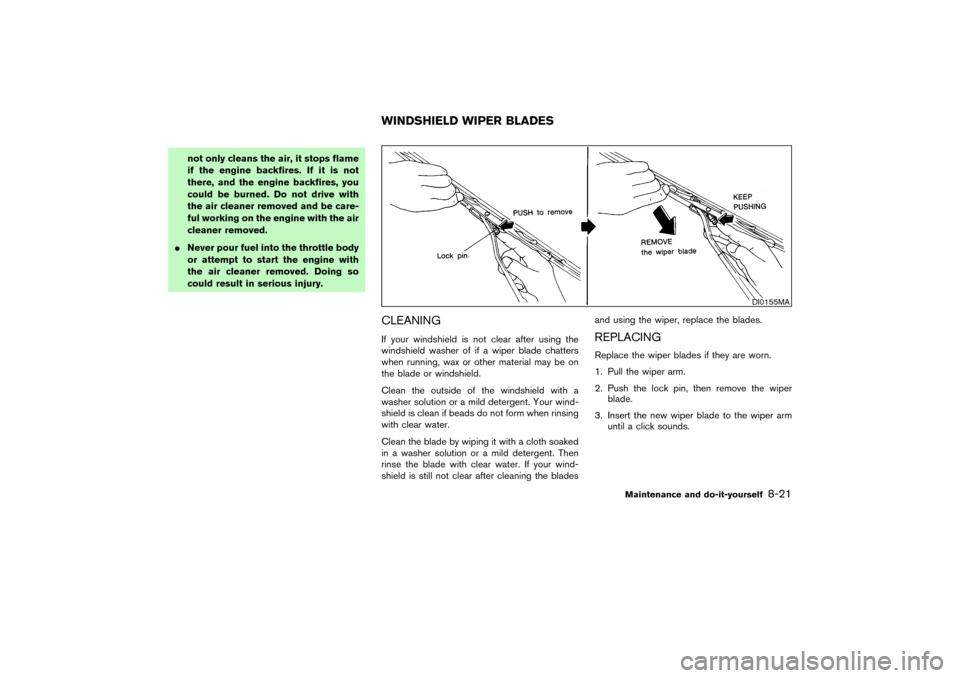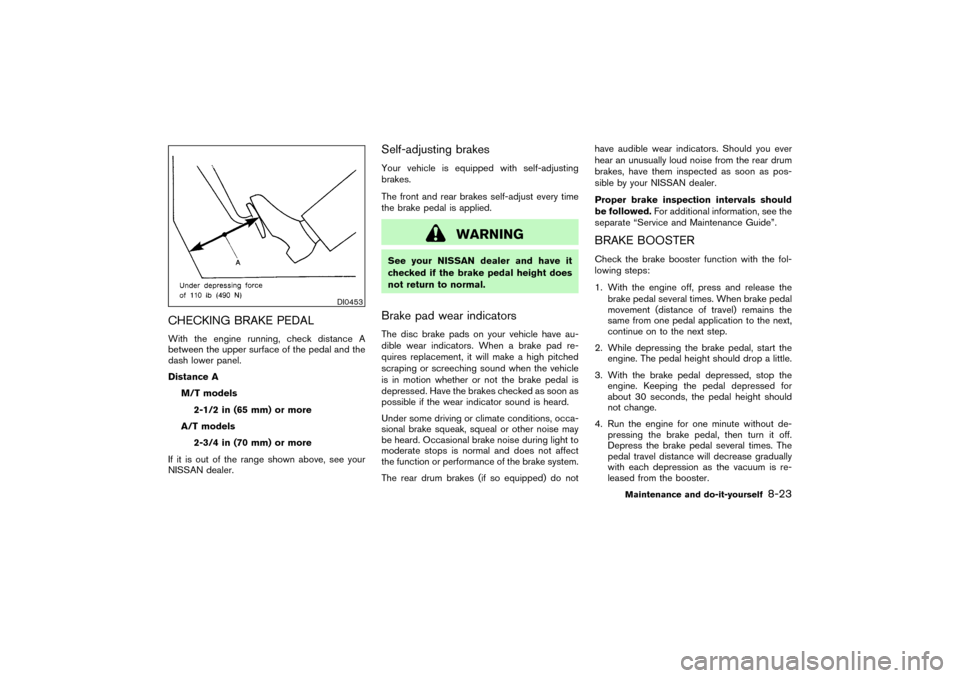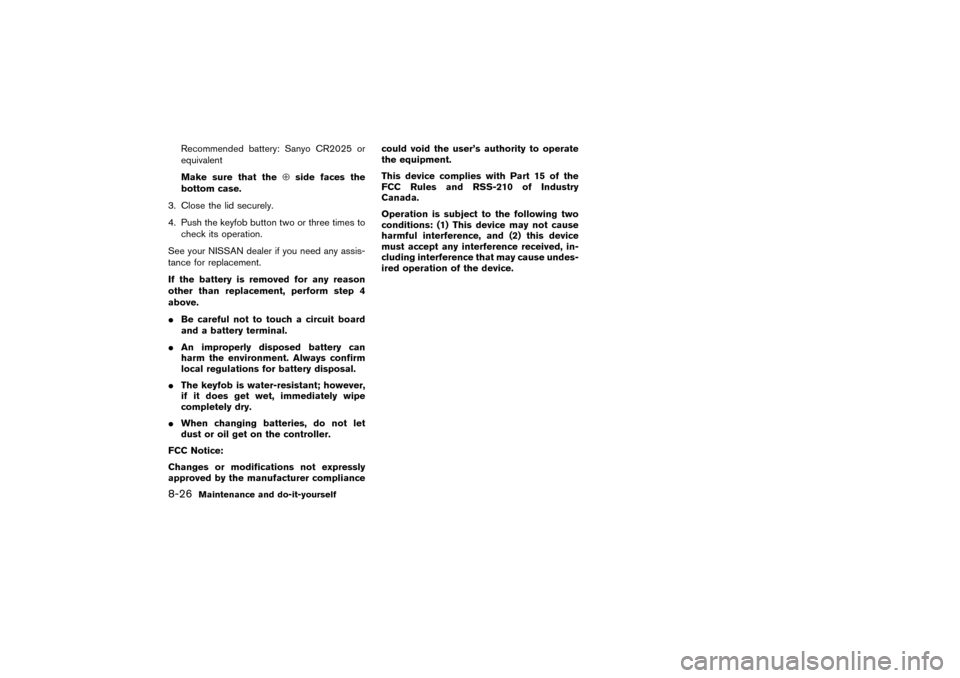Page 245 of 306
under severe conditions require frequent
checks of the battery fluid level.
WARNING
Be sure the ignition key is in the OFF or
LOCK position. The engine could rotate
unexpectedly.
1. Visually inspect each belt for signs of unusual
wear, cuts, fraying oil adhesion or looseness.
If the belt is in poor condition or loose, have
it replaced or adjusted by your NISSAN
dealer.
2. Have the belts checked regularly for condi-tion and tension.
SDI1480
SDI1119
DRIVE BELTS
Maintenance and do-it-yourself
8-19
�
04.3.9/R50-D/V5
�
Page 246 of 306

REPLACING SPARK PLUGS
WARNING
Be sure the engine and ignition switch
are off and that the parking brake is
engaged securely.
CAUTION
Be sure to use the correct socket toremove the spark plugs. An incorrect
socket can cause damage the spark
plugs.
Platinum-tipped spark plugsIt is not necessary to replace the platinum-
tipped spark plugs as frequently as the conven-
tional type spark plugs since they will last much
longer. Follow the maintenance schedule, but do
not reuse them by cleaning or regapping.
If replacement is required, see your NISSAN
dealer for servicing.
Always replace with recommended
platinum-tipped spark plugs.
The filter element should not be cleaned and
reused as it is given a special treatment. We
recommended it be replaced according to the
maintenance log shown in a separate “Service
and Maintenance Guide”. When replacing the
filter, wipe the inside of the air cleaner housing
and the cover with a damp cloth.
WARNING
�Operating the engine with the air
cleaner removed can cause you or
others to be burned. The air cleaner
SDI0145A
SDI1115
SPARK PLUGS AIR CLEANER8-20
Maintenance and do-it-yourself
�
04.3.9/R50-D/V5
�
Page 247 of 306

not only cleans the air, it stops flame
if the engine backfires. If it is not
there, and the engine backfires, you
could be burned. Do not drive with
the air cleaner removed and be care-
ful working on the engine with the air
cleaner removed.
�Never pour fuel into the throttle body
or attempt to start the engine with
the air cleaner removed. Doing so
could result in serious injury.
CLEANINGIf your windshield is not clear after using the
windshield washer of if a wiper blade chatters
when running, wax or other material may be on
the blade or windshield.
Clean the outside of the windshield with a
washer solution or a mild detergent. Your wind-
shield is clean if beads do not form when rinsing
with clear water.
Clean the blade by wiping it with a cloth soaked
in a washer solution or a mild detergent. Then
rinse the blade with clear water. If your wind-
shield is still not clear after cleaning the bladesand using the wiper, replace the blades.
REPLACINGReplace the wiper blades if they are worn.
1. Pull the wiper arm.
2. Push the lock pin, then remove the wiper
blade.
3. Insert the new wiper blade to the wiper arm
until a click sounds.
DI0155MA
WINDSHIELD WIPER BLADES
Maintenance and do-it-yourself
8-21
�
04.3.9/R50-D/V5
�
Page 248 of 306
CAUTION
After wiper blade replacement, return
the wiper arm to its original position;
otherwise it may be damaged when the
hood is opened.
Make sure the wiper blade contacts the
glass, otherwise the arm may be dam-
aged from wind pressure.
Worn windshield wiper blades can dam-
age the windshield and impair driver
vision.
If you wax the surface of the hood, be
careful not to let wax get into the washer
nozzle. This may cause clogging or im-
proper windshield washer operation. If wax
gets into the nozzle, remove it with a
needle or small pin.
CHECKING PARKING BRAKEPull the parking brake lever up. If the number of
clicks is out of the range as listed above, see
your NISSAN dealer.
SDI1136
DI1010-C
PARKING BRAKE AND BRAKE
PEDAL
8-22
Maintenance and do-it-yourself
�
04.3.9/R50-D/V5
�
Page 249 of 306

CHECKING BRAKE PEDALWith the engine running, check distance A
between the upper surface of the pedal and the
dash lower panel.
Distance A
M/T models
2-1/2 in (65 mm) or more
A/T models
2-3/4 in (70 mm) or more
If it is out of the range shown above, see your
NISSAN dealer.
Self-adjusting brakesYour vehicle is equipped with self-adjusting
brakes.
The front and rear brakes self-adjust every time
the brake pedal is applied.
WARNING
See your NISSAN dealer and have it
checked if the brake pedal height does
not return to normal.Brake pad wear indicatorsThe disc brake pads on your vehicle have au-
dible wear indicators. When a brake pad re-
quires replacement, it will make a high pitched
scraping or screeching sound when the vehicle
is in motion whether or not the brake pedal is
depressed. Have the brakes checked as soon as
possible if the wear indicator sound is heard.
Under some driving or climate conditions, occa-
sional brake squeak, squeal or other noise may
be heard. Occasional brake noise during light to
moderate stops is normal and does not affect
the function or performance of the brake system.
The rear drum brakes (if so equipped) do nothave audible wear indicators. Should you ever
hear an unusually loud noise from the rear drum
brakes, have them inspected as soon as pos-
sible by your NISSAN dealer.
Proper brake inspection intervals should
be followed.For additional information, see the
separate “Service and Maintenance Guide”.
BRAKE BOOSTERCheck the brake booster function with the fol-
lowing steps:
1. With the engine off, press and release the
brake pedal several times. When brake pedal
movement (distance of travel) remains the
same from one pedal application to the next,
continue on to the next step.
2. While depressing the brake pedal, start the
engine. The pedal height should drop a little.
3. With the brake pedal depressed, stop the
engine. Keeping the pedal depressed for
about 30 seconds, the pedal height should
not change.
4. Run the engine for one minute without de-
pressing the brake pedal, then turn it off.
Depress the brake pedal several times. The
pedal travel distance will decrease gradually
with each depression as the vacuum is re-
leased from the booster.
DI0453
Maintenance and do-it-yourself
8-23
�
04.3.9/R50-D/V5
�
Page 250 of 306
If the brakes do not operate properly, have the
brake checked by your NISSAN dealer.
ENGINE COMPARTMENT
CAUTION
Never use a fuse of higher or lower
amperage rating than that specified on
the fuse box cover. This could damage
the electrical system or cause a fire.
If any electrical equipment does not operate,
check for an open fuse.
1. Be sure the ignition key and the headlight
switch are OFF.2. Open the engine hood.
3. Remove the fuse box cover.
4. Remove the fuse with the fuse puller.
5. If the fuse is open, replace it with a new fuse.
6. If a new fuse opens again, have the electrical
system checked and repaired by your
NISSAN dealer.
Fusible linksIf any electrical equipment does not operate and
fuses are in good condition, check the fusible
links. If any of these fusible links are melted,
replace only with genuine NISSAN parts.
SDI0395
FUSES
8-24
Maintenance and do-it-yourself
�
04.3.9/R50-D/V5
�
Page 251 of 306
PASSENGER COMPARTMENTIf any electrical equipment does not operate,
check for an open fuse.
1. Be sure the ignition key and the headlight
switch are OFF.
2. Pull to open the fuse box cover/coin tray.
3. Pull down the fuse box cover/coin tray to
remove it.
4. Remove the fuse with the fuse puller.
5. If the fuse is open, replace it with a new fuse.
6. If a new fuse opens again, have the electricalsystem checked and repaired by your
NISSAN dealer.
KEYFOB BATTERY REPLACEMENTReplace the battery as follows:
1. Open the lid using a suitable tool.
2. Replace the battery with a new one.
SDI1169
SPA1374
Maintenance and do-it-yourself
8-25
�
04.3.9/R50-D/V5
�
Page 252 of 306

Recommended battery: Sanyo CR2025 or
equivalent
Make sure that the⊕side faces the
bottom case.
3. Close the lid securely.
4. Push the keyfobbutton two or three times to
check its operation.
See your NISSAN dealer if you need any assis-
tance for replacement.
If the battery is removed for any reason
other than replacement, perform step 4
above.
�Be careful not to touch a circuit board
and a battery terminal.
�An improperly disposed battery can
harm the environment. Always confirm
local regulations for battery disposal.
�The keyfob is water-resistant; however,
if it does get wet, immediately wipe
completely dry.
�When changing batteries, do not let
dust or oil get on the controller.
FCC Notice:
Changes or modifications not expressly
approved by the manufacturer compliancecould void the user’s authority to operate
the equipment.
This device complies with Part 15 of the
FCC Rules and RSS-210 of Industry
Canada.
Operation is subject to the following two
conditions: (1) This device may not cause
harmful interference, and (2) this device
must accept any interference received, in-
cluding interference that may cause undes-
ired operation of the device.
8-26
Maintenance and do-it-yourself
�
04.3.9/R50-D/V5
�